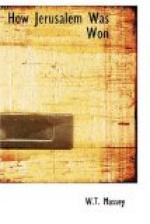The work began for the battle of Rafa, and the enemy positions on the Magruntein hill were all set out before General Chetwode when the Desert Column attacked and scored an important victory. Then when 12,000 Turks were fortifying the Weli Sheikh Nuran country covering the wadi Ghuzze and the Shellal springs, not a redoubt or trench but was recorded with absolute fidelity on photographic prints, and long before the Turks abandoned the place and gave us a fine supply of water we had excellent maps of the position. In time the whole Gaza-Beersheba line was completely photographed and maps were continually revised, and if any portion of the Turkish system of defences was changed or added to the commander in the district concerned was notified at once. To such perfection did the R.F.C. photographic branch attain, that maps showing full details of new or altered trenches were in the hands of generals within four hours of the taking of the photographs. Later on the work of the branch increased enormously, and the results fully repaid the infinite care and labour bestowed upon it.
The R.F.C. made long flights in this theatre of war, and some of them were exceptionally difficult and dangerous. A French battleship when bombarding a Turkish port of military importance had two of our machines to spot the effect of her gunfire. To be with the ship when the action opened the airmen had to fly in darkness for an hour and a half from a distant aerodrome, and they both reached the rendezvous within five minutes of the appointed time. The Turks on their lines of communication with the Hedjaz have an unpleasant recollection of being bombed at Maan. That was a noteworthy expedition. Three machines set out from an aerodrome over 150 miles away in a straight line, the pilots having to steer a course above country with no prominent landmarks. They went over a waterless desert so rough that it would have been impossible to come down without seriously damaging a plane, and if a pilot had been forced to land his chance of getting back to our country would have been almost nil. Water bottles and rations were carried in the machines, but they were not needed, for the three pilots came home together after hitting the station buildings at Maan and destroying considerable material and supplies.




